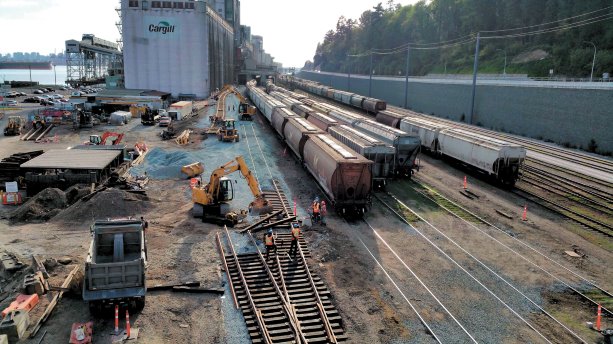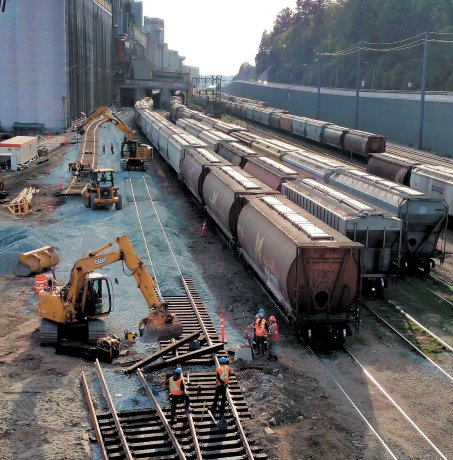The Canadian West was built on grain exports and they remain an important part of the country’s economic fabric. The Cargill Track Expansion Project completed in November 2016 continues that long tradition by allowing Cargill Ltd. to increase grain receiving capability at its North Vancouver Terminal.
The $21.5-million project was completed by contractor PCL Constructors Westcoast Inc. over a little more than 16 months, with the assistance of electrical contractor Houle Electric, mechanical contractor Termel Industries and full-service railroad contractor PNR Railworks.
The project was recently awarded a Vancouver Regional Construction Association 2017 Silver Award in the General Contractors $20 million to $45 million category.
Work on the project was complex and multi-layered, including: the replacement of grain receiving belts; installation of a new grain hopper and new drag conveyors; replacement of the existing indexer system and car openers; reconfiguration of the rail yard, including new retaining walls; a new automation system; and safety upgrades throughout the track shed.
Grain dust is potentially explosive when exposed to spark or flame and the contractor was required to develop unique construction methodologies to work in that environment.
"On a typical project, when you’re going to cut steel, you’d pull out your torch or your grinder and cut it," says Chad McPhee, project manager, PCL Constructors Westcoast Inc.
"At this facility none of that would be allowed unless you initiated a complete plant shutdown. But you simply can’t shut down the receiving area for grain from the Prairies without planning and co-ordinating it months in advance."
Instead, the contractor developed new ways of working to ensure plant safety following months of discussion with the plant safety committee.
For example, all equipment generating either heat or sparks was kept a specific radius away from the grain receiving area.
The installation of new drag conveyers early in the project required workers to cut out massive slabs of structural concrete up to two-by-two by four feet in size.
"Under normal circumstances, you would cordon the area off and saw cut it," says McPhee. "For this part of the project we created a fire blanket hoarding around all the areas of cutting and similar protection of all the equipment in the area. Westcoast Cutting & Coring Ltd. came out to do wire cutting of the concrete instead of saw cutting."
PCL worked with Termel to eliminate redundant steel plating in a third hopper being built as part of the project. Savings to the client: approximately $100,000.
Termel also adapted a series of hoist beams used to install heavy equipment so that Cargill could later use them for future maintenance work.
The project also optimized the reuse and recycling of salvaged creosote railroad ties, concrete and demolished equipment. A full-time PCL rail safety co-ordinator was assigned to the site to help construction workers adjust to a rail environment. The project recorded just one lost-time incident over 218,000 person hours.
The project’s biggest challenge involved replacing four track switches during a 48-hour shutdown of the rail yard. PCL worked closely with Cargill’s operations staff to minimize the impact to the company’s grain receiving operations.
"We started ironing this out more than a year in advance," says McPhee.
"The grain comes in from the west end of the facility, grain is dumped and the empty cars leave through the east end of the rail yard. We had to rip out the tracks and switches on the east end, so cars could come in, but couldn’t leave. Prior to shutdown, they loaded the facility with cars and sent additional grain shipments to other facilities for the shutdown period."
PCL developed pictorial schedules to assist contractors in staging their work efficiently. In all, the blackout period involved 100 tradespeople working approximately 2,500 person hours.
"After working round the clock, we completed the shutdown phase of the project one hour ahead of schedule," says McPhee. "It was one of the biggest risks to the project, but it turned out to be a well-executed endeavour."

The $21.5-million Cargill Track Expansion Project was completed in November 2016 by PCL Constructors Westcoast Inc. It was recently awarded a Vancouver Regional Construction Association Silver Award in the General Contractors $20 million to $45 million category.
Photo: PCL Constructors Westcoast Inc."










Recent Comments
comments for this post are closed